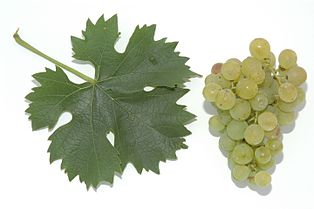Bouvier (grape variety)
| Bouvier | |
|---|---|
| Synonyms | Findling - for more see the Synonyms section |

|
|
| Art | Grape vine ( Vitis vinifera subsp. Vinifera ) |
| Berry color | green |
| use | |
| origin | Slovenia, Bad Radkersburg (Southeast Styria) |
| known since | 1910 |
| breeder | Clotar Bouvier |
| Breeding year | around 1900 |
| VIVC no. | 1625 |
| ancestry | |
|
Cross of |
|
| List of grape varieties | |
Bouvier is a white wine variety that is mainly grown in the Austrian Burgenland . The grapes ripen early. The wine is low in acidity , has a light nutmeg aroma and ripens early and is often used to produce young or predicate wines.
In Germany it is listed under the synonym "Foundling" in the cultivation statistics.
origin
The Bouvier grape variety was bred by the banker and landowner of the same name, Clotar Bouvier (1853–1930), on his estate in what is now the Slovenian Herzogenberg ( Hercegovščak ) near Oberradkersburg from the Pinot and Yellow Muscat varieties. The grape variety spread in what was then Austria-Hungary through the sale of cuttings .
Ampelographic features
- The tip of the shoot is hairy with white wool with a red border.
- The shoot growth is medium strong.
- The leaf is medium-sized and has three to five lobes.
- The grape is small to medium-sized, has loose berries and has medium-sized berries with a thick skin and a nutmeg flavor. Berries have a high sugar content.
Ripe: The grapes ripen very early - August.
Yield
The yield is low to medium and irregular. Compared to other varieties, the grapes have a low must yield.
Expectations
The Bouvier variety requires deep, light to medium-heavy, nutrient-rich soils and a good water supply. The lime content of the soil should not be too high. Regarding the location, the variety can also be cultivated in late-ripening locations.
Wine
The wines are low in acidity and have a fine nutmeg aroma. Young wines ripen very quickly, but also age earlier as a result.
The grapes are often used for the Austrian specialty Sturm , a cloudy, partially fermented must (see also Federweißer ), or processed into early-ripening young wines. With appropriate care, the grapes are also suitable for the production of sweet wines , for which a high sugar content is required. Predicate wines from Bouvier are mainly produced around the Neusiedlersee .
distribution
The variety is mainly represented in Austria, with 216 hectares comprising around 0.7% of the total area under vines. The worldwide cultivation area of Bouvier in 2010 was 250 hectares. The variety is also represented in Slovenia , Hungary and Slovakia , although it plays a subordinate role in these countries. In Germany it is listed under the synonym "Findling" in the cultivation statistics.
| country | Vineyards ha |
|---|---|
| Germany | 25th |
| Rhineland-Palatinate | 13 |
|
12 |
|
1 |
| to bathe | 12 |
Advantages and disadvantages
- advantages
- The grapes ripen very early.
- Is well suited for the production of Sturm (= Federweiser) and for predicate wines .
- The variety can also be planted in late-ripening vineyards.
- disadvantage
- Is prone to chlorosis and downy mildew .
- If the supply of nutrients and water is inadequate, the shoot growth decreases sharply.
Breeds
“Bouvier” was used as a cross partner for the following varieties: Bianca , Edelsteiner , Oremusz , Romeo , Zenit , Zeus .
Synonyms
Bela Ranina, Bela Ranka, Boouvierovo Grozno, Bouvier Blanc, Bouvier Precoce, Bouvier Grape Weisse, Bouvier Grape White, Bouvierov Hrozen, Bouvierova Ranina, Bouvierovo Grozno, Bouvierovo Hrozno, Bouvierovo Ranina, Bouvierrebe, Bouviereva Bouviereva, Bouviereva Bouviereva, Bouviereva , Bouvijerova Ranina, Bouvijerova Ranka, Bovije, Buveleova Ranka, Buvie, Buvierov Hrozen, Buvije, Buvijeova Ranina, Buvijeova Ranka, Buvijeva Ranka, Buvileova Ranka, Chasselas Bouvier, Foundling, Hartig 384, Julce De Bouvier, Preco Preco De Bouvier 1, De Bouvier Bianco, Precoce De Bouvier Blanc, Precoce Di Bouvier Bianco, Radgonska Ranina, Radgonska Ranina Bijela, Ragdonska Ranina Bela, Ranina, Ranina Bela, Ranka, Sasla Buvije.
See also
Web links
- Bouvier in the database Vitis International Variety Catalog of the Institute for Grapevine Breeding Geilweilerhof (English)
- Variety description on the website of the ÖWM
literature
- Karl Bauer, Ferdinand Regner , Barbara Schildberger: Viticulture (= AV book. ). 9th, updated edition. Cadmos, Vienna 2013, ISBN 978-3-7040-2284-4 .
- Pierre Galet : Dictionnaire encyclopédique des cépages. Hachette, Paris 2000, ISBN 2-01-236331-8 .
- Jancis Robinson : The Oxford Wine Lexicon. 3rd, completely revised edition. Hallwag, Munich 2007, ISBN 978-3-8338-0691-9 .
- Helmut Romé: The great wines of Austria. Seewald, Stuttgart-Degerloch 1979, ISBN 3-512-00558-6 .
- Directory of the Austrian quality wine grape varieties and their clones. Higher Federal College and Federal Office for Viticulture and Fruit Growing Klosterneuburg, Klosterneuburg 2008.
Individual evidence
- ^ A b c Karl Bauer, Ferdinand Regner, Barbara Schildberger: Viticulture (= AV-Fachbuch. ). 9th, updated edition. 2013.
- ↑ Bouvier (grape variety) in the database Vitis International Variety Catalog of the Institute for Grape Breeding Geilweilerhof (English)
- ^ Vineyard survey 2015, grape varieties by federal state 2015 , Statistics Austria
- ↑ Kym Anderson, Nanda R. Aryal: Which Winegrape Varieties are Grown Where? National and Global Winegrape Bearing Areas by Variety, 2000 and 2010 ; Wine Economics Research Center, University of Adelaide, South Australia, December 2013, revised July 2014. engl.
- ↑ Federal Statistical Office (2016): Agriculture and Forestry, Fisheries. Agricultural land use - vineyards. Technical series 3 series 3.1.5.
- ↑ accessed on September 19, 2016 Bouvier (grape variety) in the database Vitis International Variety Catalog of the Institute for Grapevine Breeding Geilweilerhof (English)